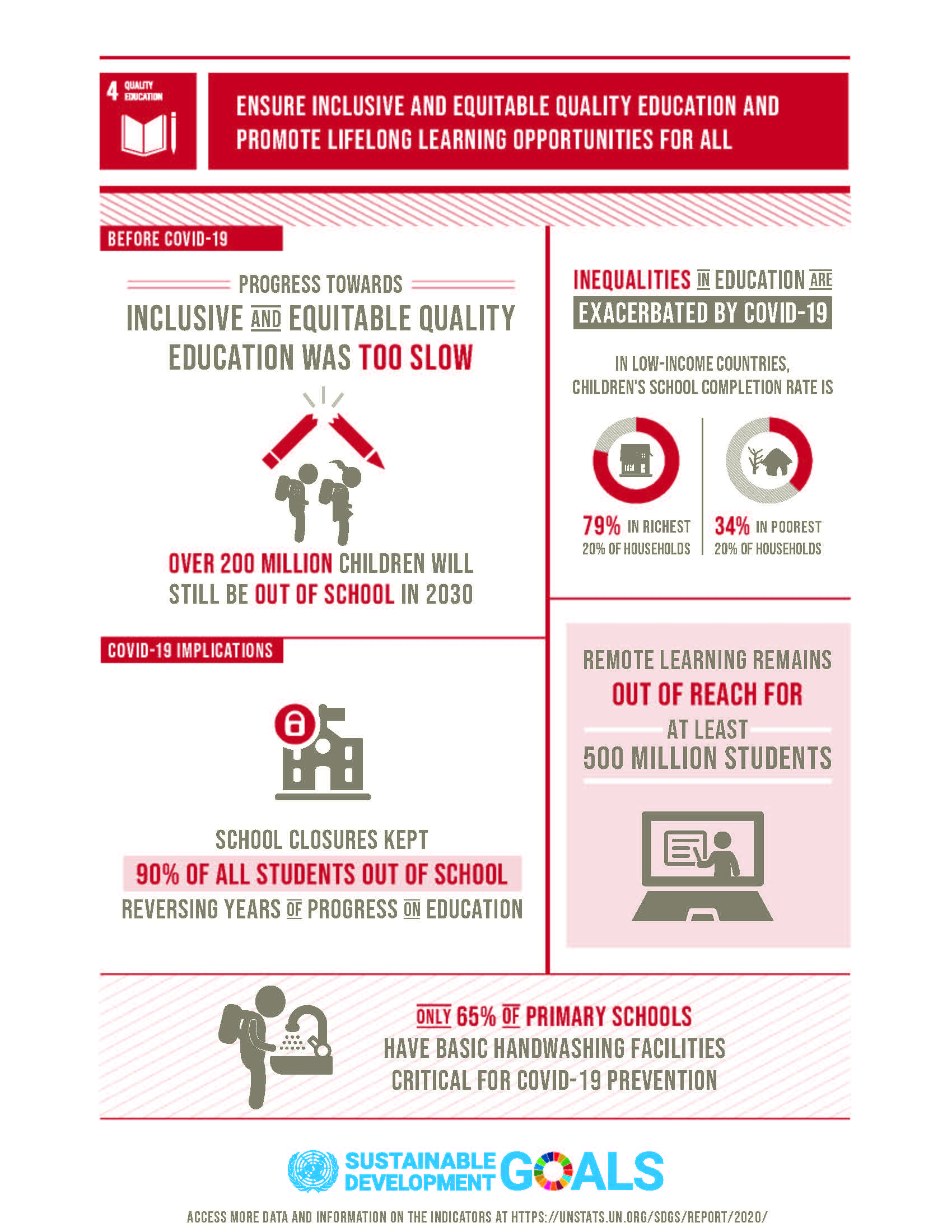Quality Education
Quality Education enables upward socioeconomic mobility and is a key to escaping poverty. Over the past decade, major progress was made towards increasing access to quality education and school enrollment rates at all levels, particularly for girls. Nevertheless, about 260 million children were still out of school in 2018 — nearly one fifth of the global population in that age group. And more than half of all children and adolescents worldwide are not meeting minimum proficiency standards in reading and mathematics.
In 2020, as the COVID-19 pandemic spread across the globe, a majority of countries announced the temporary closure of schools, impacting more than 91 per cent of students worldwide. By April 2020, close to 1.6 billion children and youth were out of school. And nearly 369 million children who rely on school meals needed to look to other sources for daily nutrition.
Never before have so many children been out of school at the same time, disrupting learning and upending lives, especially the most vulnerable and marginalised. The global pandemic has far-reaching consequences that may jeopardize hard won gains made in improving global education.
Sustainable Development Goals
The 2030 Agenda for Sustainable Development was adopted by all United Nations Member states in 2015, an agenda that provides a shared blueprint for peace and prosperity for people and the planet, now and into the future.
The 17 Sustainable Development Goals (SDGs) are an urgent call for action by all countries – developed and developing – in a global partnership. They recognize that ending poverty and other deprivations must go hand-in-hand with strategies that improve health and quality education, reduce inequality, and spur economic growth – all while tackling climate change and working to preserve our oceans and forests. Learn more about the UN SDG’s.

What is the goal here?
Ensure inclusive and quality education for all and promote lifelong learning.
Why does quality education matter?
Education enables upward socioeconomic mobility and is a key to escaping poverty. Quality education helps reduce inequalities and reach gender equality and is crucial to fostering tolerance and more peaceful societies.
Over the past decade, major progress has been made towards increasing access to quality education and school enrollment rates at all levels, particularly for girls. Nevertheless, about 258 million children and youth were still out of school in 2018 — nearly one fifth of the global population in that age group. As the COVID-19 pandemic spread across the globe, countries announced the temporary closure of schools, impacting more than 91 per cent of students worldwide. By April 2020, close to 1.6 billion children and youth were out of school.
How much progress have we made so far?
The primary school completion rate reached 84 per cent in 2018, up from 70 per cent in 2000 and under current trends, is expected to reach 89 per cent globally by 2030. In 74 countries with comparable data for the period 2011-2019, around seven in ten children aged three and four were developmentally on track in at least three of the following domains: literacy-numeracy, physical development, social-emotional development and learning. The global adult literacy rate (aged 15 years and older) was 86 per cent in 2018, while the youth literacy rate (15 to 24 years) was 92 per cent.
What challenges remain?
Despite years of steady growth in enrolment rates, non-proficiency rates remain disturbingly high. In 2018, some 773 million adults—two-thirds of whom are women—remained illiterate in terms of reading and writing skills. And the sheer magnitude of school closures due to COVID-19 is likely to set back progress on access to quality education.
Where are people struggling the most to have access to quality education?
Sub-Saharan Africa faces the biggest challenges in providing schools with basic resources. The situation is extreme at the primary and lower secondary levels, where less than one half of schools in sub-Saharan Africa have access to drinking water, electricity, computers and the Internet. Inequalities will also worsen unless the digital divide – the gap between under-connected and highly digitalized countries – is not addressed.
Are there groups that have a more difficult access to education?
Yes, women and girls are one of these groups. About one-third of countries in the developing regions have not achieved gender parity in primary education.These disadvantages in education also translate into lack of access to skills and limited opportunities in the labour market for young women.
What can we do?
Ask our governments to place education as a priority in both policy and practice. Lobby our governments to make firm commitments to provide free primary school education to all, including vulnerable or marginalized groups.
United Nation Sustainable Development Goals
(United Nations why it matters)
Facts and Figures
- Before the coronavirus crisis, projections showed that more than 200 million children would be out of school, and only 60 per cent of young people would be completing upper secondary education in 2030.
- Before the coronavirus crisis, the proportion of children and youth out of primary and secondary school had declined from 26 per cent in 2000 to 19 per cent in 2010 and 17 per cent in 2018.
- More than half of children that have not enrolled in school live in sub-Saharan Africa, and more than 85 per cent of children in sub-Saharan Africa are not learning the minimum
- 617 million youth worldwide lack basic mathematics and literacy skills.
- Some 750 million adults – two thirds of them women – remained illiterate in 2016. Half of the global illiterate population lives in South Asia, and a quarter live in sub-Saharan Africa.
- In 10 low- and middle-income countries, children with disabilities were 19per cent less likely to achieve minimum proficiency in reading than those without disabilities.
- 4 million refugee children were out of school in 2017
Goal 4 targets
- 4.1 By 2030, ensure that all girls and boys complete free, equitable and quality primary and secondary education leading to relevant and Goal-4 effective learning outcomes
- 4.2 By 2030, ensure that all girls and boys have access to quality early childhood development, care and preprimary education so that they are ready for primary education
- 4.3 By 2030, ensure equal access for all women and men to affordable and quality technical, vocational and tertiary education, including university
- 4.4 By 2030, substantially increase the number of youth and adults who have relevant skills, including technical and vocational skills, for employment, decent jobs and entrepreneurship
- 4.5 By 2030, eliminate gender disparities in education and ensure equal access to all levels of education and vocational training for the vulnerable, including persons with disabilities, indigenous peoples and children in vulnerable situations
- 4.6 By 2030, ensure that all youth and a substantial proportion of adults, both men and women, achieve literacy and numeracy
- 4.7 By 2030, ensure that all learners acquire the knowledge and skills needed to promote sustainable development, including, among others, through education for sustainable development and sustainable lifestyles, human rights, gender equality, promotion of a culture of peace and non-violence, global citizenship and appreciation of cultural diversity and of culture’s contribution to sustainable development
- 4.A Build and upgrade education facilities that are child, disability and gender sensitive and provide safe, nonviolent, inclusive and effective learning environments for all
- 4.B By 2020, substantially expand globally the number of scholarships available to developing countries, in particular least developed countries, small island developing States and African countries, for enrolment in higher education, including vocational training and information and communications technology, technical, engineering and scientific programmes, in developed countries and other developing countries
- 4.C By 2030, substantially increase the supply of qualified teachers, including through international cooperation for teacher training in developing countries, especially least developed countries and small island developing states
Links
UN Educational, Scientific and Cultural Organization
Global Education First Initiative
UN Population Fund: Comprehensive sexuality education
UN Office of the Secretary General’s Envoy on Youth
We, at AI for Good foundation, are using AI + ML initiatives in pursuit of the 17 SDGs. With various projects in progress, such as our Climate Trend Scanner and the SDG Data Catalog, we are determined to help and facilitate achieving the goals.







